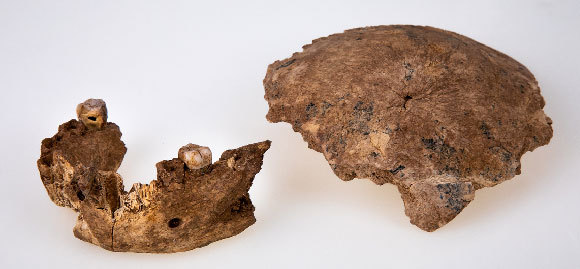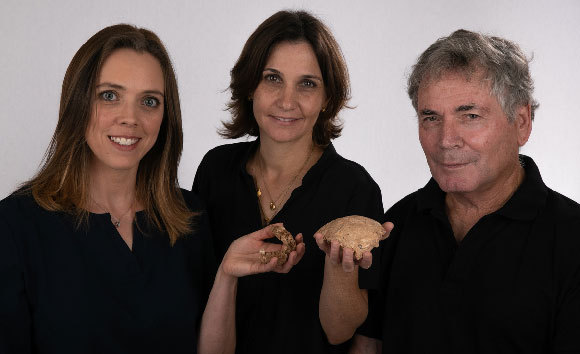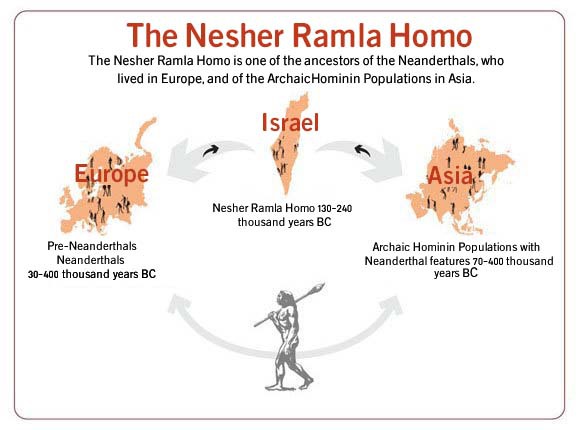Fossilized human bones found near Ramla and dating back to about 120,000 years ago, reveal the existence of a new type of human, hitherto unknown to science, from a population which may have been the source for the Neanderthals in Europe
120,000 years ago, the Israeli coastal plain looked very different from the way it does today. While there were naturally no cities or roads, the land was not, as one may think, filled with dunes, but rather looked similar to an African-like Savannah. Among the few grasses and trees, roamed antelopes, wild horses, ostriches and other animals. Humans were there too - an ancient tribe of hunter-gatherers. In a deep and wide depression created in the ground, near today’s city of Ramla, they kindled fires, created stone tools and used them, dismembered the animals they hunted, and ate them.
During the tens of thousands of years that have passed since, the depression in the ground has been covered by a thick layer of soil. Between 2010-2011, the site was exposed as part of a salvage excavation on the grounds of the Nesher cement factory, headed by Dr. Yossi Zaidner and his team from the Institute of Archaeology at the Hebrew University of Jerusalem. Tens of thousands of stone tools and tens of thousands of animal bones were found, some carrying cut marks. This would seem to indicate that humans lived at this site for a prolonged period of time.
At the lower layers of the site, two fossilized human skeletal remains were found: a partial skull and a lower jaw, which the researchers assume belonged to the same individual. Contrary to their initial expectation, it turned out that this individual did not belong to the modern human species, Homo sapiens, who had already settled in the land at the time. Nor was he a Neanderthal. Researchers from the Hebrew University, Tel-Aviv University and other universities detail their findings in two articles published in the scientific journal Science (first and second), posing the hypothesis that the man from Ramla belonged to an ancient population, different from any previously known to us, and demostrate how this discovery changes the way we understand human history.

Tens of thousands of stone tools and animal bones were found at the site, in addition to two partial skeletal remains belonging to a human. A view of the deeper parts of the excavation at the site of Nesher Ramla | Yossi Zaidner
Neither Homo Sapiens nor Neanderthal
“The jaw was found in pieces, and we managed to assemble it, mostly virtually, to a nearly complete jaw”, said Dr. Hila May to the Davidson Institute’s website. May headed the research on the fossil along with Prof. Israel Hershkovitz and Dr. Rachel Sarig, all affiliated with the Dan David Center for Human Evolution and Biohistory Research and the Shmunis Family Anthropology Institute at Tel-Aviv University. “It was clear to us right away, even before the sophisticated analyses, that it didn’t belong to Homo sapiens. It’s impossible to confuse these things”.
“He didn’t have a chin”, added Sarig. “A chin is a characteristic of modern humans. This already hinted at something other than what we expected to find, dating to this period in the land of Israel”.
Three years ago, a research article was published, showing that humans of our species (Homo sapiens) lived in Israel nearly 180,000 years ago, based on a jaw bone found in the Misliya cave in the Carmel area. Additional findings, from the Kedumim cave (Qafzeh) near Nazareth and from the Es-Skhul cave in the Carmel area, also indicated an early presence of Homo sapiens 120,000 and 90,000 years ago. The findings from Ramla were dated to between 120-140 thousand years ago, and it was therefore reasonable to expect human remains from this time period to belong to our own species.
The stone tools found there also supported this hypothesis. The tools were made using a technique previously found in sites of Homo sapiens as well as of Neanderthals and has never been seen in combination with the bones of earlier human populations.

Two parts of a human skeleton were found at the lower layers of the site: a partial skull and lower jaw. The findings from Nesher Ramla | Ilan Tailer and Avi Levin, Sackler Faculty of Medicine, Tel-Aviv University
However, the bones found in Ramla indicate that the humans living on the ancient coastal plain were not Homo sapiens. The chinless jaw was more similar to that of our Neanderthal relatives, who lived in Europe and Asia up to about 40,000 years ago, but also differed from the Neanderthal jaw in certain properties. The skull bone was flat relative to modern skulls, and resembled more the skull of earlier Homo species, Homo erectus and Homo heidelbergensis.
A molar tooth found in the jaw also exhibited properties that did not fit with our species. When the researchers compared it to teeth found in other places, in Israel and around the world, they saw that it resembled teeth found in the Qesem cave near Rosh Ha’ayin and at a site called “Sima de los Huesos” (“Pit of the Bones”) in Spain. At both sites, the findings date to 400,000 years ago, and in both cases, it is not clear which human population they belong to. The skeletons from Spain carry many Neanderthal characteristics, but also have different properties than those found in later individuals.
The researchers concluded that the man from Ramla did not belong to Homo sapiens nor was he a Neanderthal, but instead that he belonged to a different population altogether that appeared 400,000 years ago. The group living in Ramla was perhaps one of the last groups of this ancient population. They lived in our region as well as in southern Europe, and it is possible that the Neanderthals evolved from them.
The researchers preferred not to declare the finding as a new species of human, and did not name it as a separate species. They refer to it as a “Nesher Ramla morphology type” or “Nesher Ramla Homo”. “We think it’s a dangerous hobby of anthropologists – there are too many species running around”, explained Hershkovitz. “We work on morphological types, morphological variations within the same species”.
“The classical definition is that individuals belong to separate species if they cannot reproduce and bear fertile offspring”, added May. “In this case, we know that they did procreate with one another. All modern humans outside of Africa have a certain percentage of Neanderthal DNA, indicating that our ancestors mated with Neanderthals. There is no reason to think this was not the case between all types of humans. Therefore, we prefer not to call them species”.

The researchers refer to it as “Nesher Ramla Homo”. From left to right: Sarig, May and Hershkovitz, holding the partial skull and jaw found at the site | Ilan Theiler and Avi Levin, Sackler Faculty of Medicine, Tel-Aviv University
Solving Puzzles
The researchers believe that the ancient population to which the “Nesher Rama Homo” belonged, had indeed “exchanged genes” with other populations, including our species as well as the Neanderthals. As mentioned above, during the same period of time, groups of Homo sapiens existed in the region, as their fossils were found in the Mt. Carmel area and in Nazareth. However, the bones found in Ramla carried characteristics which did not completely fit those of a modern human population. “The findings from Kedumim cave and Es-skhul cave were attributed to Homo sapiens, but there’s a mess there”, said May. “Some look more Neanderthal, they have properties of both Neanderthals and Homo sapiens. The Nesher Ramla type offers a solution: there was an ancient population here alongside modern humans, and if mating occurred between the populations it could explain these characteristics.”
An ancient population such as this, existing in the Middle East for hundreds of thousands of years, could also be the solution to other Neanderthals-related puzzles. Recent genetic research has shown that certain Neanderthal groups interbred with our ancestors, early modern humans, roughly 100,000 years ago, that is, many thousands of years earlier than previously thought. However, the great migration of Homo sapiens from Africa occurred only 50,000-70,000 years ago. Indeed, it was discovered that some humans who had migrated from Africa, settled in the land of Israel even prior to that, but none of their descendants are alive today, and it seems that they did not venture further than the Middle East. The humans who settled in Europe, Asia, Australia, and later also America, and whose descendants reside on these continents today, all left Africa during the great migration 70,000 years ago at the earliest. The Neanderthals, however, lived only in Europe and Asia, and as far as we know, have never been in Africa.
According to Hershkovitz, this is one of the big challenges that genetics has posed to paleontologists: explaining the flow of genes from Homo sapiens to Neanderthals at such an early stage. If the ancient population that the Nesher Ramla man belonged to exchanged genes with Homo sapiens that had arrived from Africa before the great migration, and also associated with Neanderthals in Europe and in eastern and northern Asia, this could be the solution for the hitherto unexplained gene flow.
Another puzzle is associated with genetic findings that suggest that Neanderthals settled in Europe multiple times, with each wave of settlement replacing its predecessor. Where did those waves of migration originate? It is possible that they came from our area, says Hershkovitz. “They were the human reservoir replenishing the Neanderthal population. Whenever the weather improved, there was migration from this region to Europe”.

Nesher Ramla people could have been the human reservoir that replenished the Neanderthal population
Learning From Each Other
It is possible to learn about the interaction of the Nesher Ramla people with groups of Homo sapiens who also settled the land, from the tools they left behind. These are tools made using a stone knipping technology termed Levallois. Many of the flint tools are made by a precise strike of a stone, causing a small and sharp piece to break off from it. The Levallois technique involves pre-planning by the knapper, to determine the flake’s final shape. These tools are characteristic of Homo sapiens and were found in the Kedumim cave and the Es-skhul cave, in addition to other sites in Israel. Similar tools were also discovered in other Neanderthal sites in other countries.

In the Levallois technique of stone knapping, the knapper makes initial preparations of the stone, to pre-determine the final shape of the flake. An example of a Levallois point found at the site | Tal Rogovski
The researchers conducted a detailed comparison between tools found at the Nesher Ramla site and tools belonging to other groups of Homo sapiens, found in other locations in Israel, and concluded that they are highly similar, not only in their final shape but also in the method of their production, which can be inferred from the debris that includes the flakes that are created during tool knapping. “There is similarity throughout the whole knapping sequence”, says Zaidner. The significance of this is that one of the groups must have learned this technology from the other.
“If you find a tool tossed in the field and you happen to like its shape, you can try and copy it – but you’ll do it using your own method”, explained Zaidner. The imitation of the method itself suggests that interactions between the groups took place. “It shows that they did not just meet each other briefly, or from a distance – they observed how a flint knapper from the other group makes his tools, and learned from him. This is a close social interaction”.
We don’t know who was the first to develop the Levallois technique, who brought it to our area or who was the one to teach whom - the Nesher Ramla people teaching the Homo sapiens population, or vice versa. But this research can give us a glimpse of this intimate encounter, which took place so long ago, between two different populations of humans: sitting together, perhaps around the bonfire, and learning from each other.
